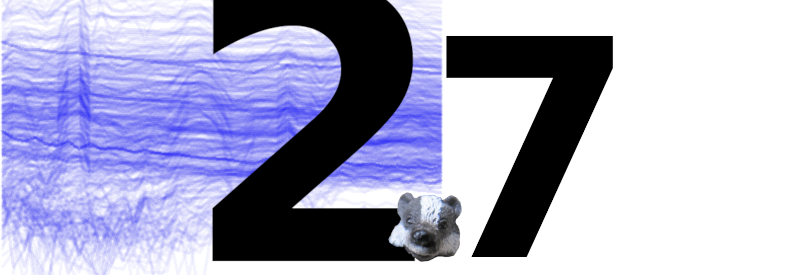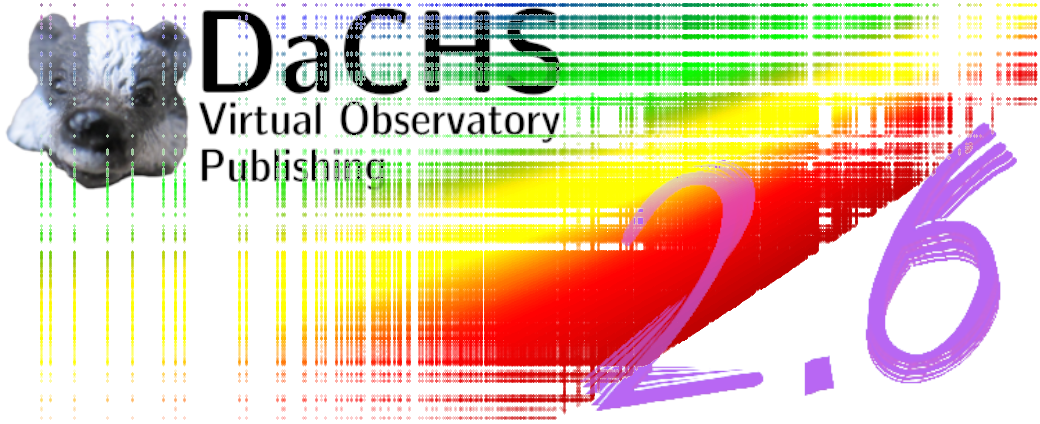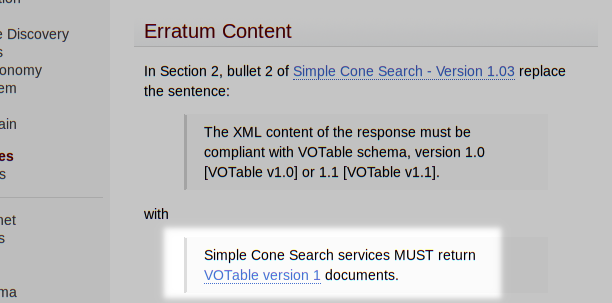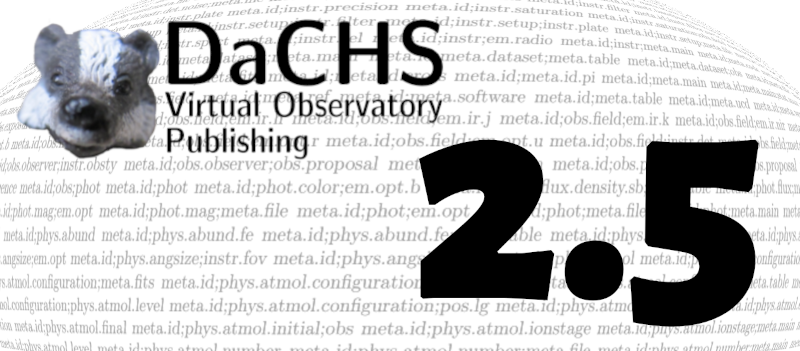DaCHS 2.8 is out
Today, I have released DaCHS 2.8 and uploaded it to our APT repository; it should also appear in Debian unstable within the next two weeks. This is the traditional post on what is new in this release.
If I had to name the highlights of what was added since version 2.7, released last November, I would probably say it's HiPS support and the general move towards SIAPv2, although I would have to admit that both did not involve large amounts of code, in particular when compared to the various changes related to COOSYS and TIMESYS.
So, what about HiPS support? As you probably know, HiPSes are zoomable images (or catalogues, too); if you have a survey-like image collection published through SIAP, you owe it to yourself to have a look at this.
Given HiPSes are so interactive in Aladin and the like, it may be surprising that they do not really require an active server component: technically, they are just a directory tree created and organised in a very clever way. So, why would DaCHS have a HiPS renderer and boast about it? Well, there are a few amenities (such as auto-generated hips.params files and properties once you have your RD), and DaCHS will care about the Registry side of a HiPS publication. For details, see the HiPS section in the tutorial.
The SIAP2 story is that (against my rather substantial skepticism) people insisted on creating a new image search protocol in the early 2010s. Since it doesn't have tangible benefits over the venerable SIA1 and even less over Obscore, DaCHS so far has limited its support for SIAP2 to a single global SIAP2 service based on the Obscore table. But then SIAP1 with its stinky UCDs does show its age, and since support for SIAP2 in various clients has been falling into place over the last few years, DaCHS now nudges you to publish your images through SIAP2, for instance by producing a template for a SIAP2 service in dachs start.
SIAP2 is also what the image section of the tutorial now reflects. If you already have SIAP1 services, the migration should not be hard (except where you used the siapCutoutCore), but given occasional shakiness in the SIAP2 support of the various tools, I'd still wait for a year or two; I have certainly no plans to remove SIAP1 from DaCHS within the next ten years or so. If you still want to migrate, feel free to ask for a section on doing so in DaCHS' How Do I? document.
From the department of “this update may break your service”: I you have SODA cutouts of cubes, this update will rather likely break the cutout on the non-spatial axis. To fix things, if that axis is spectral, pass its index in a spectralAxis parameter to //soda#fits_standardDLFuncs (or to //soda#fits_makeWCSParams, if that's what you use)[1]. On the other hand, you can now define a velocityAxis, too (and for other cases, there is still axisMetaOverrides).
Among the more generally interesting new features may be the UnionGrammar. This is for when you have multiple sorts of inputs that require different parsers, for instance, when the data provider changes the formats in which they deliver the data in the midst of a project. I would hope the example from the unionGrammar documentation illustrates what this could be useful for:
<unionGrammar>
<handles pattern=".*\.txt$">
<reGrammar...>
</handles>
<handles pattern=".*\.csv$">
<csvGrammar...>
</handles>
</unionGrammar>
Also note that you can create some uniformity between what the grammars yield (and thus avoid a lot of if-else-ing in the rowmaker) by using rowfilters.
I would have needed the union grammar several times before but had always quickly hacked around that need with some custom grammar. Another itch that has in this way come up multiple times before and for which 2.8 has what I think is a reasonable solution: I occasionally want to share some logic between multiple RDs, but that logic is not general enough to go into DaCHS itself. For such situations, you can now drop a file local.py into your configuration directory (usually, /var/gavo/etc).
In code saying from gavo import api (which is what you should in general do when programming against DaCHS; in procs, say <setup imports="gavo.api"/>), you can then access the names defined in there as api.local.<name>. For instance (and that's not contrived), say your observers have several particularly babylonian ways of writing times, and you have to parse these in several data collections (i.e., RDs). You could then add a function like this to your local.py:
def parse_babylonian_time(raw_time:str) -> float:
"""Tries to interpret raw_time as a time in one of the many forms
our observers like so much.
Here is the syntaxes supported by the function:
>>> parse_babylonian_time("1h")
3600.0
>>> parse_babylonian_time("4h30m")
16200.0
>>> parse_babylonian_time("1h30m20s")
5420.0
>>> parse_babylonian_time("20m")
1200.0
>>> parse_babylonian_time("10.5m")
630.0
>>> parse_babylonian_time("1m10s")
70.0
>>> parse_babylonian_time("15s")
15.0
>>> parse_babylonian_time("s23m")
Traceback (most recent call last):
ValueError: Cannot understand time 's23m'
"""
mat = re.match(
r"^(?P<hours>\d+(?:\.\d+)?h)?"
r"(?P<minutes>\d+(?:\.\d+)?m)?"
r"(?P<seconds>\d+(?:\.\d+)?s)?$", raw_time)
if mat is None:
raise ValueError(f"Cannot understand time '{raw_time}'")
parts = mat.groupdict()
return (float((parts["hours"] or "0h")[:-1])*3600
+ float((parts["minutes"] or "0m")[:-1])*60
+ float((parts["seconds"] or "0s")[:-1]))
(or something similarly abominable). That way, the function is available to all RDs, there is just one implementation to maintain, and it can be centrally tested (dachs test could certainly do with with a facility to execute local.py doctests, too).
DaCHS 2.8 also comes with yet another way to declare space-time metadata. That's a longer story, and while all this should have happened 10 years ago, there's no particular hurry now. I will therefore write about improvements in TIMESYS and COOSYS in a later post dedicated to votable:Coords and its products. Meanwhile, just two things: In the unlikely case you already have “stc2“ annotations in your RDs, you will have to rename the value attribute in space clauses to location. And: SSAP and SIAP now produce proper TIMESYS-es. If you happen to know the timescales and reference positions of your observation dates, starting in 2.8 you can define them in the respective mixins (the refposition and timescale mixin parameters).
There are two notable additions in DaCHS' Datalink support (which is newly declared to support version 1.1): For one, you can now pass contentQualifier to descriptor.makeLink[FromFile], which will normally be a product type taken from http://www.ivoa.net/rdf/product-type (e.g., “image” or “dynamic-spectrum“). Because they can help clients select appropriate clients to send a datalink to, it is certainly a good thing to add them to your datalinks where applicable.
Also, datalink meta makers can now return ProcLinkDef instances. This lets you have multiple distinct processing services within a single Datalink document. To make that a bit prettier, there is also a secret handshake (as in: an INFO element with a name of title) between DaCHS' datalink service and the XSLT that formats datalink documents in browsers (also available for third-party datalink documents). See multiple processing services in the reference for details.
Let me briefly mention a few more changes you may be interested in:
- condDescs can now be declared as inputOptional, which is useful when you want to have syntax-adaptive defaults.
- you can now configure the size of DaCHS connection pools in [db]poolSize (in particular, set it to 0 to disable connection pooling).
- in ADQL, you can now do things like CONTAINS(CIRCLE(23, 42, 1), some_moc) (i.e., compute boolean predicates between the classical geometries and MOCs).
- DaCHS no longer fails with numpy-s later than 1.23, and is no longer dependent on the cgi module that is scheduled for removal from python. In consequence, there is a new dependency, python3-multipart.
| [1] | That is, unless you already defined spectralAxis because DaCHS' heuristics were wrong before version 2.8. But then your service won't break, either. |

![[RSS]](../theme/image/rss.png)



